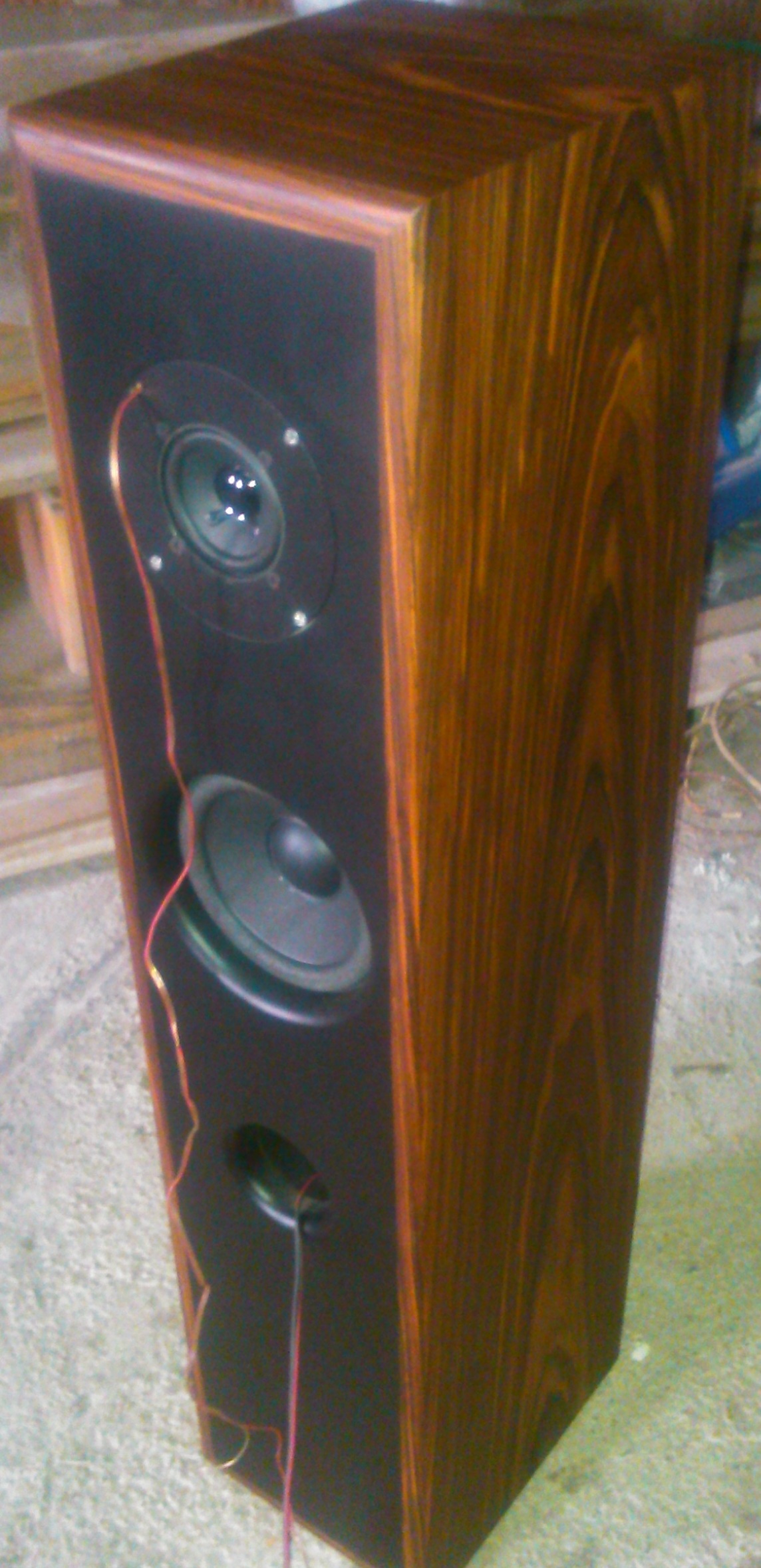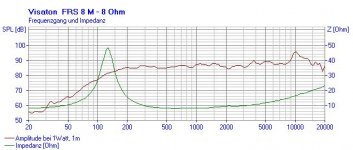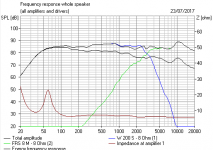You're forgetting SD...
It's all but forgotten. Mms includes acoustic load of the air that interacts with the dome/cone. If i was talking about Mmd you'd be right - but i wasn't.
...There is many dome tweeters whith less details than good small fullrange..
Other side of the coin would be statement that goes something like - there are many small fullrange with less detailed sound than a good dome tweeter.
Where does that leaves us ?
I was talking about D2608/91300 and Morel CAT308 in particular - both can be bought at staggering 70$ or less. I am trying to avoid blunt statements, that's why i gave an example with the comparable data. Examples are everywhere, like Fountek FR88EX and Gladen Aerospace 28mm tweeter.
Last edited:
I am trying to avoid blunt statements, that's why i gave an example with the comparable data.
Money doesn't mean anything in hifi.. imagine that sound quality is most important for price, than Alpair drivers will cost 5 cent..
Data which you post tell us nothing.. details are everywhere, less directive driver doesn't means less details..
Money doesn't mean anything in hifi.. imagine that sound quality is most important for price, than Alpair drivers will cost 5 cent...



...Data which you post tell us nothing...
Well, maybe to you they don't. To me they do tell about where directivity begins to narrow, and what is the amount of energy at certain frequency that gets to the listener depending on angle of listening. Quite important for making xovers, for positioning of the speakers and for predicting the nature of reflections in an untreated room. Waterfall/CSD tells me about uniformity of decay and that is quite usefull - to see where are resonances, how wide and how high/low in level they are. Also, to see how fast the loudspeaker stops after the input signal has ended. The latter i think has very much to do with sense of detail in a loudspeaker.
...details are everywhere, less directive driver doesn't means less details...
I do agree with bolded one.
Last edited:
They only tell us about frequency which driver can play, nothing about how can play....they do tell about where directivity begins to narrow, and what is the amount of energy at certain frequency that gets to the listener depending on angle of listening..
You can use Morel CAT308 and ScanSpeak D2608 from 2kHz with +-1dB, but I'm sure that second will have more details..
They only tell us about frequency which driver can play, nothing about how can play..
You can use Morel CAT308 and ScanSpeak D2608 from 2kHz with +-1dB, but I'm sure that second will have more details..
Maybe, maybe not.
I'm certain of one thing - you'll never know for sure.
Last edited:
Perfectly backwards.To me they do tell about where directivity begins to narrow, and what is the amount of energy at certain frequency that gets to the listener depending on angle of listening.
You can't hear beaming even though you can make swell diagrams of it. That should be obvious. Beaming is not a perceptual experience.
Sound reaching your seat is perceptible.
B.
Perfectly backwards.
You can't hear beaming even though you can make swell diagrams of it. That should be obvious. Beaming is not a perceptual experience.
Sound reaching your seat is perceptible.
B.
Sound that reflects of walls, floor and ceiling is also reaching your ears and effects the tonality - unless you are listening in an anechoic chamber.
So you are listening to a full range that goes up to 20KHz on axis but starts to beam at 3KHz. You move 10" to one side and you don't hear change in tonality ?
Nice
Last edited:
Maybe, maybe not.I'm certain of one thing - you'll never know for sure.
In next few weeks I will listen D2608..
Don't know difference between CAT308 and older Morel 32 and 33.. but that older ones doesn't have any more details than Visaton B80, direct comparison with Dayton RS28A-4 and Visaton KE25SC was ridiculous..
Yes of course, that's why you have it backwards. You have to start with the results for the listener, not with the speaker. And, if possible in a typical if not specific room. You can't hear beaming only the complex consequences of dispersion in a room.Sound that reflects of walls, floor and ceiling is also reaching your ears and effects the tonality - unless you are listening in an anechoic chamber.
So you are listening to a full range that goes up to 20KHz on axis but starts to beam at 3KHz. You move 10" to one side and you don't hear change in tonality
If you are arguing about hearing at 20kHz, the many changes that always happen for many reasons as you move your hear an inch, and 10-degree lobes, then you are arguing for the defence of your ego, not about human music perception.
These arguments have been examined at great length in past discussions of the Geddes speaker with waveguide treble (which he builds to have good dispersion definition).
B.
Last edited:
Yes of course, that's why you have it backwards. You have to start with the results for the listener, not with the speaker. And, if possible in a typical if not specific room. You can't hear beaming only the complex consequences of dispersion in a room....
Yes... Complex consequences of beaming in case of extended range direct radiator that has to cover everything from 500Hz to 20000Hz.
...If you are arguing about hearing at 20kHz, the many changes that always happen for many reasons as you move your hear an inch, and 10-degree lobes, then you are arguing for the defence of your ego, not about human music perception...
Now you're just spinning the subject by trying to be politely insulting. At this moment i'm arguing about existence of change in tonality from 3KHz-20KHz as a product of a different dispersion pattern in extended range direct radiator speaker compared to classic dome tweeter. Only presumption is that they are both of good quality as they can be and are implemented correctly. If you can not hear it or know how to measure it, lots of us can. That is one of the reasons people don't use cheaper, but in your opinion superior mid-hi 3" extended range drivers instead of tweeters.
...These arguments have been examined at great length in past discussions of the Geddes speaker with waveguide treble (which he builds to have good dispersion definition).
B.
I'd like you to find and post the arguments here. I too have spent quite amount of time reading Earl's papers and posts. I consider him one of leading authorities on the subject. I'm quite curious what exactly are you referring to in his posts that will counter what i have written.
Last edited:
Zvu, I quite like a cone tweeter myself. I looked at the 3" Visaton FRS 8 M, which is conveniently more efficient than your FRS 8.

But what I run into is that a 3" driver just naturally breaks up at 10 kHz. It's how it works. Just like a 6" driver breaks up at 5kHz. Some severe problems at 10 kHz anyway. Maybe a supertweeter should kick in a bit lower. It would help dispersion too. A traditional weakness of cones. All, in speakers is compromise.
But what I run into is that a 3" driver just naturally breaks up at 10 kHz. It's how it works. Just like a 6" driver breaks up at 5kHz. Some severe problems at 10 kHz anyway. Maybe a supertweeter should kick in a bit lower. It would help dispersion too. A traditional weakness of cones. All, in speakers is compromise.
Attachments
I use the TG9 myself. I know that the TC9 has received a lot of praise so I threw it in there as well.
Madisound gave us 2 pr of the TG9 for raffle prizes for this year’s diyFEST. Just heard the TG9s and it is clear they are a big step up from the TC9. Right after the TG9 we switched in the Mark Audio Alpair 5.2eN which were at least an order of magnitude superior, especially better with low level detail (DDR).
dave
- Status
- This old topic is closed. If you want to reopen this topic, contact a moderator using the "Report Post" button.
- Home
- Loudspeakers
- Multi-Way
- Opinions: Tweeter Crossover - High vs Low?

